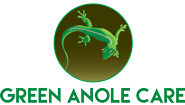Green Anole Dietary Guidelines:
- Don’t feed your green anole non-insects. Spiders, ticks, centipedes, and scorpions are hazardous. All spiders are venomous and an inopportune bite could cause some serious damage. The same holds true for centipedes and scorpions. If it has more than six legs, don’t use it as food for your anole.
- Insects use warning coloration very extensively as a defense mechanism. If an insect is brightly colored or conspicuous, it is usually toxic or unpalatable. It is best to be safe.
- Don’t feed your green anole insects (or ticks) that are disease or parasite vectors. It is not likely that your pet anole would be affected by West Nile Virus but it will probably pass through its digestive tract unscathed and then be present in his feces. Not a good situation. The same applies to internal parasites.
- If an insect is feeding on a plant with milky sap, don’t use it as a food item. Most plants with milky latex-like sap are toxic. Insects have the amazing facility of not being bothered by the toxins but they also frequently concentrate them in their tissues. Thus, they can be even more toxic that the plant itself.
- Don’t collect insects from areas treated with pesticides (no surprise) or from roadsides where the exhaust from motor vehicles will be a problem because of heavy metal concentrations.
Green Anole Food Recommendations:
This will not be a complete listing of all of the insect Orders but will focus on the larger and more frequently encountered ones. The first seven are those that have an incomplete metamorphosis. That is, the nymphs generally look like miniature adults.
Orthoptera: Crickets, grasshoppers, roaches, etc. This is a large and nutritious Order. Almost all of the members are suitable as green anole food. There are a few exceptions, however. Stay away from household roaches (American cockroach and German cockroach) since they are prone to carry diseases. Mole crickets and mantids are also inappropriate choices. Any other suitably sized specimen will do. If you choose to breed and raise some of these species, here are a couple of websites to visit for excellent instructions of food, housing, etc.




